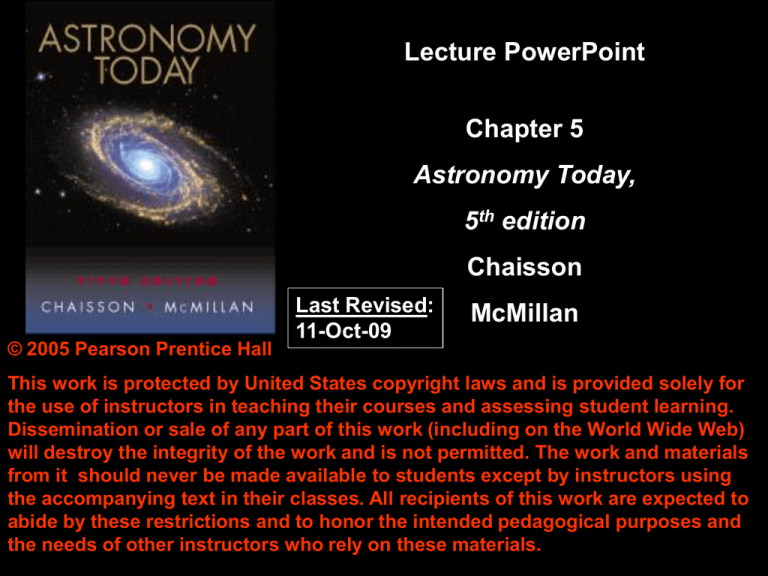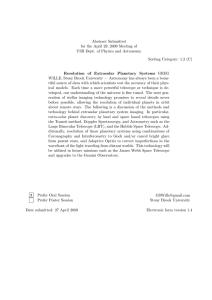
Lecture PowerPoint
Chapter 5
Astronomy Today,
5th edition
Chaisson
© 2005 Pearson Prentice Hall
Last Revised:
11-Oct-09
McMillan
This work is protected by United States copyright laws and is provided solely for
the use of instructors in teaching their courses and assessing student learning.
Dissemination or sale of any part of this work (including on the World Wide Web)
will destroy the integrity of the work and is not permitted. The work and materials
from it should never be made available to students except by instructors using
the accompanying text in their classes. All recipients of this work are expected to
abide by these restrictions and to honor the intended pedagogical purposes and
the needs of other instructors who rely on these materials.
Chapter 5
Telescopes
Units of Chapter 5
Telescope Types
Refractors & Reflectors
Telescope Designs
Prime focus, Newtonian, Cassegrain,
Coudé focus, Schmidt camera
Images and Detectors
Eye, Photography, Thermocouples,
Photoelectric detectors, CCDs
• Telescope Size
Light Gathering Power
Angular Resolution
• High-Resolution Astronomy
• Radio Astronomy
• Interferometry
Origin
Visible
Radio
• Space-Based Astronomy
The Hubble Space Telescope
Other Wavelength Observatories:
Chandra, Spitzer, Compton and
more
• Full-Spectrum Coverage
Telescopes in Astronomy
• The science of optics and lenses begins
with the great Arab scientists of the 11
and 12th centuries (Alhazen - The Book of
Optics)
• Invented as an outgrowth of the use of
lenses (word from “lentils” for their
shape) for magnifiers and eyeglasses in
Europe (13th-15th centuries) as glass
quality improved (Venetian glass)
• Invention of telescope is attributed to
Hans Lipper(s)hey in Holland where
much early work in optics took place.
• The microscope was also invented
there by Zacharias and Hans Janssen
• and developed by
Anton
Van Leeuwenhoek
(“father of
microscopy”).
• This is when we first observed microscopic life
forms
Telescopes in Astronomy
• Galileo was the first to use the telescope for
astronomy and he used it to observe things
in the sky that supported the Copernican
theory of the heliocentric cosmos like the
moons of Jupiter
• He also observed that the Milky Way was
composed of millions of stars, Venus had
phases, the Moon had geographical features
similar to Earth (and the maria weren’t seas!)
and the Sun had spots
• After that various designs of telescopes
became developed and sizes of the
objectives slowly increased for the next 300
years
More Telescope History
• Newton and Gregory developed the reflecting
telescope to avoid the chromatic aberration
effects of lenses.
• Reflectors also avoid the polishing of extra
surfaces and the need for perfectly
transmitting glass
• Reflectors also are supported from behind
while lenses can only be held by their edges.
For large heavy lenses this means they will
sag
• Until recently there was only one “largest
telescope in the world” - sometimes for
decades!
Important Historic Telescopes
• Lord Rosse’s “Leviathan” using a 6 foot
speculum mirror
• World’s largest telescope for 75 years!
• Used to study the “spiral
nebula” we now know are
other galaxies
The Whirpool Galaxy (M51)
• He drew and named many of the famous
“nebulae” like the Crab (M1) and Owl (M97)
Supernova
remnant
Planetary
Nebula
5.1 Telescope Design
Images can be formed through reflection or
refraction
Refracting lens is a version of a prism:
Refraction and Reflection
Snell’s Law
nisinθi = nrsinθr
Law of reflection
θi = θr
5.1 Telescope Design
Reflecting mirror:
Parabolic surfaces
will bring all rays
to same focal pt.
Spherical surfaces
will not do that.
They suffer from
spherical aberration
5.1 Telescope Design
Reflecting and refracting telescopes:
Keplerian
Refractor
Newtonian
Reflector
• Large lenses can be very heavy, and can only be
supported at the edges limiting the size that refractors
can have
• The largest ever built are:
Lick Obs. 36˝ (1888)
and Yerkes Obs. 40˝ (1897)]
5.1 Telescope Design
Differential refraction leads to
chromatic aberration:
• Chromatic aberration can be corrected to a great
degree by using compound lenses called achromats
(2 elements) or apochromats (3 elements)
•Uses different types of glass with
different indices of refraction to bring
colors closer to a common focus
•All lenses and mirrors suffer from the
five Seidel aberrations:
spherical, coma, astigmatism,
curvature of field and distortion
•Spherical aberration in mirrors can
be eliminated by using a parabolic
surface
or a Schmidt corrector plate
Seidel Aberrations
COMA
Curvature of Field
Astigmatism
Distortions
End of an Era
• Refractors are still made for special purposes but
not the very large ones like Yerkes and Lick
• The great telescope makers like Alvan Clark & Sons
Carl Lundin
took their secrets to the grave
• When the Yerkes 40” had to be
repolished no one knew what the
2 lenses of the achromat were
glued together with!
• They had to use modern spectral
techniques to figure it out
optician
Yerkes
lens
The Reflector Revolution
• George Ellery Hale (1868-1938)
•Built the Yerkes 40” refractor - the last
and largest refractor ever constructed
•Built the 60” Carnegie reflector on Mt.
Wilson, CA the largest glass mirror
telescope ever (1908). It was the
world’s largest telescope at that time
and the biggest since Lord Rosse’s
“Leviathan” telescope
Andrew Carnegie
with Hale at the 60”
Revolution Continued
• Next he built the most important ground
based optical telescope of the 20th century:
the 100” Hooker telescope on Mt. Wilson
This is the telescope that changed our
view of the universe!
The Real Location of the Sun
• Harlow Shapley (1885-1972)
Director of the Harvard Observatory used
this telescope in 1914-18 to discover that
the Sun was not near the center of the
Milky Way universe (as it was thought of
at the time) but out near the edge and
that the Milky Way was 10 times bigger
than anyone had thought:
Old Milky Way Universe
Sun
100,000 ly
Is the Milky Way the Whole Universe?
• Edwin Hubble (1889-1953)
Uses the 100” Hooker in 1923-24 to prove
that the Andromeda Nebula (M31) is
another Milky Way
The Cepheid
variable star
This puts an end to
used to find
the “Great Debate”
the distance
about whether the
to M31
Milky Way is the
whole universe
Later in 1926 Hubble, still using the 100”,
he showed that all the spiral nebulae
(galaxies) were moving away from us.
This later leads to the “Big Bang” idea.
5.1 Basic Telescope Designs
Types of reflecting telescopes:
Reaching the Limits of Old Mirror
Technology
After Hale built the Yerkes
40” refractor, the 60”
Carnegie and the 100”
Hooker reflectors he
then designed the 200”
Hale telescope for the
Mt. Palomar Obs.
Using funds from the
Rockefellers!
1948 dedication
The Limit of Thick Mirror Slabs
- Soviet project that copied 5m Hale type optics but 6m size
- Now called the Special Astrophysical Observatory (SAO)
- Large thermal mass of mirror prevented it from working as
well as the Hale 5m
- Its use of an alt-azimuth mount was successful leading all
new large telescopes to use that type of mount
New Technology Telescopes
• To get around the problem seen at the SAO a new path to
large optics had to be found
• First prototype was the Multiple Mirror Telescope (MMT) on
Mt. Hopkins, AZ
• A mosaic of six 6’ mirrors whose alignment was controlled
by lasers and computers on an alt-azimuth framework
New Technology Telescopes
• Another technique developed was the method of spincasting mirrors using rotating ovens developed by Roger
Angel of the U. of Arizona
Explosion of Building of NTTs
VLT
Gemini (N & S)
Subaru
Magellan
Keck I and II
5.2 Images and Detectors
• Human eye
Retina has 2 types of detectors:
rods are responsible for
vision in low light
cones are responsible for color
vision and detail.
Daguerrotype
• Photographic Detection
Begins in 1827 with Niepce
Daguerre & Henry Fox Talbot (1839)
develop more modern methods.
Talbot creates “calotype” or images on
paper like today.
[see the book “The Pencil of Nature”]
Talbot
Photography & Astronomy
John W. Draper (1811–1882)
•Takes first astronomical photo ever
in 1839. The Moon as seen from
Central Park, NY.
•Takes first successful portrait photo
(his sister Dorothy) in 1840
•NYU professor & MD; partner with Samuel Morse
Henry Draper (1837-1882)
•Son of John Draper
•Dean of medicine NYU
•First photo of Orion Nebula
•Started the taking and cataloguing stars
by their spectra
•Wife Anna donated money to Harvard
Observatory to continue his work
•Led to the famous Henry Draper Catalogue
compiled by Annie Jump Cannon & others
Photography & Astronomy
• Means that from the mid 19th Century on we
could take permanent images of sky objects
and their spectra. No more grossly
subjective drawings by individual observers.
• We can go back years later and look in the
photos for what may have changed or went
unnoticed until a later date.
• Think of how you take for granted the
beautiful pictures from the HST and other
telescopes!
Modern Electronic Light Detectors
• Thermocouples
• Photoelectric Detectors
Uses the photoelectric effect (photons make e-s)
• Bolometers
Cryogenics (liquid nitrogen, liquid He)
• Photometers & Photometry
Measures intensities of light sources
Especially important for stellar magnitude
determinations and
Variable star studies (AAVSO)
• Charged Coupled Devices (CCD detectors)
Digital images produced directly from pixels
• Fiber optics
Uses total internal reflection effect to allow light
to travel within the fiber
5.2 Images and Detectors
Image acquisition: charge-coupled devices
(CCDs) are electronic devices – can be read
pixels
out and reset quickly
These are the detectors that are now in
your digital cameras and cell phones
5.2 Images and Detectors
Digital Image processing (think Photoshop) by
computers can sharpen images:
5.2 Images and Detectors
• CCDs can also measure intensity, or brightness
• Spectroscopy can be done using filters or masks
•The Hubble
Space Telescope
has several
instruments:
ACS, NICMOS,
WFPC2, STIS to
take pictures and
spectra
5.3 Telescope Size
Two reasons why larger telescopes are more
desirable:
• Larger diameter telescopes
have better angular
resolution:
sin θ = 1.22λ/D
• Larger telescopes also
have more light
gathering power:
I ≈ (πD2)/4
(a)
5.3 Telescope Size
Light-gathering power:
Improves detail
Brightness proportional
to square of radius of
mirror
Right: (b) was taken with
a telescope twice the size
of (a)
Andromeda
Galaxy (M31)
(b)
5.3 Telescope Size
unresolved
Resolving power: When
better, can distinguish
objects that are closer
together
Resolution is proportional
to wavelength and
inversely proportional to
telescope size
just resolved
completely resolved
5.3 Telescope Size
Effect of improving angular resolution:
(a) 10′; (b) 1′; (c) 5″; (d) 1″
(a)
(c)
(b)
(d)
Observational Problems For
Astronomers
• Weather
Function of where you observe from
Used to be near cities
• Light Pollution
Modern problem
• Atmospheric turbulence
Temperature and air density varies
Air is a fluid and moves like disturbed
water in a pool causing blurred images
Light Pollution in USA
Light Pollution in Europe
Light Pollution in Asia
5.4 High-Resolution Astronomy
Atmospheric turbulence: due to air movements
also called “seeing” or scintillation
5.4 High-Resolution Astronomy
Solutions:
• Put telescopes on mountaintops, especially
in deserts
• Put telescopes in space
• Active/adaptive optics – control mirrors
based on temperature and orientation
OFF
ON
5.4 High-Resolution Astronomy
Adaptive optics: track atmospheric changes with
laser, adjust mirrors in real time
Laser
artificial
guide star
Starfire Optical
Range (Kirtland
AFB, NM) where
Robert Fugate
pioneered this
technique
5.5 Radio Astronomy
Radio telescopes:
• Similar to optical reflecting
telescopes
• Prime focus
• Less sensitive to
imperfections (due to longer
wavelength); can be made
very large
Beginnings of Radio Astronomy
Karl Jansky (early 1933) Bell
•Labs-wireless phones
research!
•Discovers center of Milky Way
is a strong radio source
Grote Reber (1937)
•First parabolic radio dish
•Published first radio astronomy papers
and radio maps (1940,44)
5.5 Radio Astronomy
Largest radio telescope: 300-m dish at Arecibo
5.5 Radio Astronomy
Longer wavelength means poor angular resolution
Advantages of radio astronomy:
• Can observe 24 hours a day
• Clouds, rain, and snow
don’t interfere
• Observations at an
entirely different
frequency; get totally
different information
Orion Nebula (M42)
Map of CO molecules
5.6 Interferometry
Midshipman at USNA
First Jewish graduate
• Albert Abraham Michelson (1852-1931)
Michelson interferometer disproved the existence of
the luminiferous aether. The alleged medium that
light needed to travel through the universe
Most accurate speed of light measurements
Basis of the modern day CAT, MRI and PET scanners
1907 Nobel prize (1st science
one to an American)
Mt. Wilson Observatory Library
Humason, Hubble, St. John, Michelson,
Einstein, Campbell, Adams (director)
Note painting of Hale behind them
Michelson Interferometers
Michelson-Morley Apparatus
Stellar interferometer
atop the 100” Hooker
telescope at Mt. Wilson
"My honored Dr. Michelson, it was you who led the physicists into
new paths, and through your marvelous experimental work paved
the way for the development of the theory of relativity."
-Albert Einstein
5.6 Interferometry
Interferometry:
• Combine information from several widely-spread
radio telescopes as if they came from a single dish
• Resolution will be that of dish whose diameter =
largest separation between dishes
Very Large Array (VLA) near Socorro, NM
Radio
5.6 Interferometry
Can get radio images whose
resolution is close to optical:
Interferometry can also be
done with IR & visible light,
but much harder due to the
shorter wavelengths:
VIS
IR
5.7 Space-Based Astronomy
Infrared radiation can image where visible
radiation is blocked; generally can use optical
telescope mirrors and lenses
View from
Mt. Wilson
Obs.
Trapezium
stars in Orion
Nebula
5.7 Space-Based Astronomy
Infrared telescopes can also be in space; this is
the Spitzer telescope:
Other Space Observatories
Compton (CGRO)
(γ-ray)
IRAS
(IR)
Chandra (x-ray)
IUE (UV)
Einstein (HEAO-2)
(x-ray)
Who are These Telescopes
Named For?
• Spitzer InfraRed Telescope Facility
(SIRTF)
Lyman Spitzer, Jr. (1914-1997)
Founder of study of the interstellar medium (ISM)
Founded the Princeton Plasma Physics
Laboratory – first place where nuclear fusion reactor
reached the energy breakeven point
Led the program to design an observatory
which would orbit the Earth – this become the Hubble
Space Telescope (HST)
He was able to watch its launch in 1990. This was 54
years after he had first proposed the idea in 1946!
Who are These Telescopes Named For?
• Compton Gamma Ray Observatory
Arthur Holly Compton (1892-1962)
•1927 Nobel Prize in Physics for the Compton Effect
an experiment that proved photons had particle properties
•Proved extraterrestrial origin of cosmic rays
• Chandra X-ray Observatory
•Subramanyan Chandrasekhar (1910-1995)
•1983 Nobel Prize in physics for his theories of
white dwarfs neutron stars and black holes
•The Chandrasekhar limit (1.4Mo) for White Dwarfs
• Einstein Observatory (HEAO-2)
Albert Einstein (1879-1955)
We all know who he was!
Theory of Special relativity
(part of which is E = mc2)
Theory of General Relativity
(the curvature of spacetime by mass)
Explained the photoelectric effect
Nobel Prize in physics in 1921
With J. Robert
Oppenheimer
(Manhattan
Project)
Spitzer observations of M81 at 3 different
infrared wavelengths and the composite picture
24 μm
8 μm
3.6 μm
All 3
Old stars predominate in the central portion of the galaxy,
while the graceful spiral arms are dominated by infrared
emission from dust. Massive stars are being born in the
bright clumps within the spiral arms.
5.7 Space-Based Astronomy
Ultraviolet observing must be done in space, as
the atmosphere absorbs almost all ultraviolet rays
Ultraviolet images of Venus and two supernova
remnants:
Venus
Cygnus Loop
Crab Nebula
5.7 Space-Based Astronomy
X rays and gamma rays will not reflect off mirrors
as other wavelengths do; need new techniques
X rays will reflect at a very shallow angle, and
can therefore be focused:
Grazing incident
optics
5.7 Space-Based Astronomy
X-ray images and spectra of supernova remnants:
Chandra (NASA)
Cas A (1680)
XMM-Newton (ESA)
Tycho (1572)
5.7 Space-Based Astronomy
Gamma rays cannot be focused at all; images are
therefore coarse:
Compton Gamma Ray Obs.
(CGRO)
Gamma Ray blazar in
the quasar 3C279
5.8 Full-Spectrum Coverage
Much can be learned from observing the same
astronomical object at many wavelengths. Here, the
Milky Way: Radio
IR
VIS
Gamma
X-ray
Summary of Chapter 5
• Refracting telescopes make images with a lens
• Reflecting telescopes with a mirror
• Modern research telescopes are all reflectors
• CCDs are used for data collection
• Data can be formed into image, analyzed
spectroscopically, or used to measure intensity
• Large telescopes gather much more light,
allowing study of very faint sources
• Large telescopes also have better resolution
Summary of Chapter 5, cont.
• Resolution of ground-based optical telescopes
is limited by atmospheric effects
• Resolution of radio or space-based telescopes
is limited by diffraction
• Active and adaptive optics can minimize
atmospheric effects
• Radio telescopes need large collection area;
diffraction limited
• Interferometry can greatly improve resolution
Summary of Chapter 5, cont.
• Infrared and ultraviolet telescopes are
similar to optical telescopes
• Ultraviolet telescopes must be above
atmosphere
• X rays can be focused, but very differently
than visible light
• Gamma rays can be detected but not
imaged





